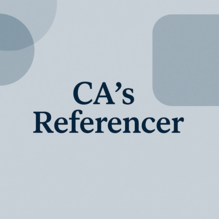GSTR-9 annual return FY 2024-25: Key change in reporting Table 6 explained
Oct 14, 2025
Synopsis
A significant change has been introduced in the GSTR-9 annual return form. This update, effective for FY 2024-25 with a December 31, 2025 deadline, introduces a new table for reporting input tax credit from the previous year. This aims to enhance clarity and reduce notices. The article also addresses frequently asked questions regarding GST rates applicable from September 22, 2025.
Chartered Accountant Deep Koradia recently pointed out a change in the GSTR-9 annual return form, which has a submission deadline of December 31, 2025 for FY 2024-25. It’s important to note that there are two types of GST annual return forms- 9 and 9A. The change in table 6 reporting only applies to GSTR-9 form.
On X (formerly Twitter), Koradia said on September 19, 2025: Welcome change for GSTR-9 reporting. In table 6, now the separate table for reporting of ITC pertains to previous year has been notified. (which Ideally should match with previous year's Table 13-12, except some border line rare cases) Exemption for some of the Tables of Annual Return also notified for FY 24-25.
Bhogavalli Mallikarjuna Gupta, Associate Director - GST, RSM India, agreed with Koradia and further added that the recent introduction of Table 6A1 in GSTR-9 marks a significant step forward in improving clarity and transparency.
Gupta says that this new table fills in the previous data gaps related to input tax credit (ITC) claims for earlier financial years, which frequently resulted in notices being issued.
According to Gupta, “...With Table 6A1, taxpayers can now present a more accurate and reconciled view of their ITC claims, aiding both the assessee and the tax officer during desk reviews. This not only minimizes the chances of scrutiny or notices but also helps reduce litigation costs in terms of both time and money. However, to fully benefit from this development, taxpayers must ensure their books of accounts and working papers are well-maintained and accurate. The department is likely to compare the figures in Table 12( reversal of ITC) and 13(for availing ITC)of the previous year return with those reported in the current year Table 6A1 for consistency and verification.”
Some frequently asked questions about GST rates applicable from September 22, 2025
1. In addition to exempting individual health and life insurance services, will any input services of insurers also be exempted?
Only reinsurance services are exempt. Other inputs such as commissions and brokerage remain taxable, and insurers cannot claim ITC on them once the output supply is exempt. Such ITC will have to be reversed.
2. Will passenger transportation services be taxed at 18%?
No. Passenger transport by road will continue at 5% without ITC, though operators may opt for 18% with ITC. In the case of air travel, economy class is taxed at 5%, while other classes remain at 18%.
3. What is the applicable GST rate on multimodal transport of goods?
If the multimodal transport does not include any air leg, it is taxed at 5% with limited ITC (restricted to 5% of the value). If any portion involves air transport, the applicable rate is 18% with full ITC.
4. Who is liable to pay GST on local delivery services provided through an ECO?
If local delivery services are provided through an e-commerce operator (ECO) by an unregistered person, the e-commerce operator is responsible for paying GST. If the service provider is registered, then that provider is liable to pay the tax.
5. What is the GST rate applicable on local delivery services?
Local delivery services are taxed at 18%. If the supplier is registered, the supplier pays GST. If the supplier is unregistered and provides services through an e-commerce platform, the operator pays GST.
6. Are local delivery services provided through an ECO covered under the scope of GTA?
No. Local delivery services through e-commerce platforms are not considered as Goods Transport Agency (GTA). They are treated as a separate category of service.
7. Is it necessary to recall and re-label the MRP on medicines already in the supply chain before 22nd September, 2025? How will the re-labelling be carried out?
No stock recall is needed. Manufacturers only have to issue revised price lists and share them with dealers, retailers, and regulators. Stocks already in the market can continue to be sold, provided billing reflects the new prices.
8. Why haven’t all medicines been fully exempted from GST?
Exempting medicines would prevent manufacturers from claiming ITC on raw materials and inputs, raising their production costs. These costs would eventually be passed on to consumers. Keeping medicines at a concessional 5% rate (except those specified at nil rate) ensures affordability while allowing ITC to flow through the supply chain.
9. Why hasn’t agricultural machinery been fully exempted from GST?
If agri-machinery is made fully tax-free, manufacturers lose input tax credit on raw materials, raising their costs. These higher costs would be passed on to farmers, making machinery more expensive. Hence, it is kept taxable at a concessional rate to balance relief for farmers and viability for manufacturers.
[The Economic Times]


